Divertimento for Strings
By Jean-Pierre Hebert, Rosalind Reid
An artist's homage to theoretical physics as the Einstein centenary ends
An artist's homage to theoretical physics as the Einstein centenary ends

DOI: 10.1511/2005.56.488
An observer wanders through science as if exploring a landscape. Here theories grow like trees. They branch, they leaf; storms of controversy and conflicting evidence toss and sometimes uproot them. The ground is littered with fallen theories—yet afresh with new ones.
Happily engaged since 2003 as artist-in-residence at the Kavli Institute of Theoretical Physics at the University of California, Santa Barbara, conceptual artist Jean-Pierre Hébert has been wandering part of that landscape with sketchbook in hand. As we close the World Year of Physics, Hébert's doodles pay homage both to his favorite artists and to the theorists who today follow in the footsteps of Albert Einstein, seeking the most fundamental insights possible into the nature of the physical world.
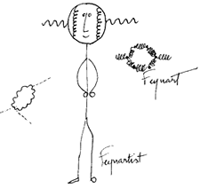
In the string-theory community that frequently gathers at KITP, the concept of a landscape itself ignites both controversy and Hébert's imagination. String theory proposes a way of uniting the quantum and relativistic physical theories that have resisted, since Einstein's day, all efforts to knit them into a unified theory. Today there is a "landscape" in string theory—not a sturdy tree but an intertwining overgrowth of possibilities, highly mathematical and yet teasingly connected to recent findings in astronomy that have turned one of Einstein's predictions on its head. This very landscape of possible momentary universes that turn themselves inside out, manifesting hyperbolic geometries and endless symmetries, curled-up dimensions and other dizzying physical and mathematical attributes, is the stuff of inspiration for an admirer of cubism and surrealism.
In the artist's imagination, versions of space in which our universe is a hologram or a surface folded in on itself are child's play, a trick of a pen guided by artistic imagination. In truth, the myriad of possibilities imagined by string theorists today is an enormous challenge: Until theoretical or experimental tests trim back the thicket, theorists risk predicting nothing by predicting everything.
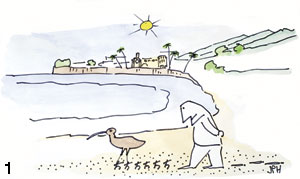
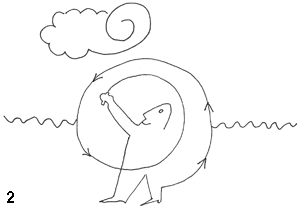
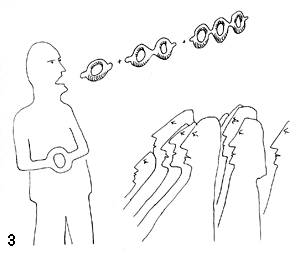
Meanwhile an amused and admiring Hébert notices, from his seaside perch: a California shorebird whose tracks to a physicist bear a teasing resemblance to Planck's constant, or "h-bar" (1); and in a cloud overhead, the beginning of a Feynman diagram representing a gluon, the carrier of the strong force in the theory of QCD, or quantum chromodynamics (2). Not to mention the fact that—perhaps as the talk goes on, and mealtime approaches—the tori described by a topologist to an attentive string-theory audience begin to look like, well, just so many extruded doughnuts (3).
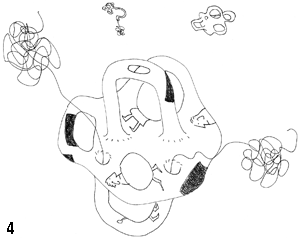
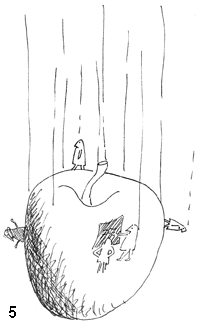
In the artist's eye, strings form a topologically complex "multiverse" populated by bubble-physicists and covered with a patchwork of equation-filled blackboards (4). Newton's apple is falling precipitously to Earth, endangering physicists busy calculating the effects of gravity on the pommes falling through their own terrain (5).
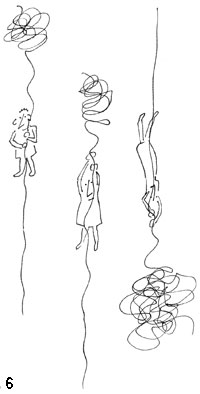
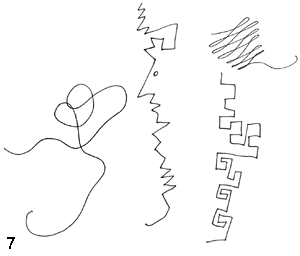
In this idea-space, string theorists hitch themselves to ideas that take them in rather diverse directions (6). And what about the "anthropic principle"? (7) If human beings live in this universe, permitted to do so by the local physical laws, and string theory suggests there must be other universes with different physics where we couldn't live, what does it mean that there is a universe such that we can live in it? Finally, a literally open mind may be what's implied by de Sitter space, where an empty, highly symmetrical universe is exponentially expanding (8).
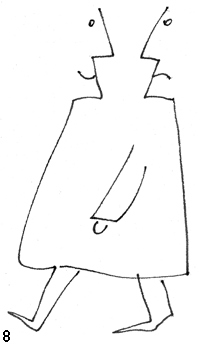
The minds of ordinary mortals are sorely taxed by these questions, but the "Feynartist" need not answer them. He can be content to enjoy and find inspiration in a landscape that yields, a century after the notion of relativity took root there, abundant food for the scientific imagination.
Click "American Scientist" to access home page
American Scientist Comments and Discussion
To discuss our articles or comment on them, please share them and tag American Scientist on social media platforms. Here are links to our profiles on Twitter, Facebook, and LinkedIn.
If we re-share your post, we will moderate comments/discussion following our comments policy.